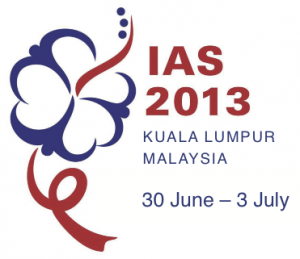Efavirenz at 400 mg compared to standard 600 mg dose has similar efficacy with fewer side effects
25 July 2013. Related: Conference reports, Antiretrovirals, IAS 7th Kuala Lumpur 2013.

Simon Collins, HIV i-Base
Results from the ENCORE1 study comparing efavirenz at a reduced compared to standard dose in treatment naive patients, were presented as an oral later breaker by Rebekah Puls from the University of New South Wales, Sydney. [1]
This was a double-blind, placebo-controlled, non-inferiority trial that randomised 636 patients (1:1) to efavirenz dosed at either 400 mg (n=324) or 600 mg (n=312). Tenofovir/FTC was used as the dual RTI backbone for all patients, with participants taking four pills daily because efavirenz/placebo used 200 mg capsules.
Entry criteria included CD4 50-500 cells/mm3 and viral load >1000 copies/mL. The primary endpoint was virological suppression to <200 copies/mL at week 48, with follow-up planned until week 96. Non-inferiority was determined using a lower margin of -10%.
Both arms were well matched and baseline demographics included mean (+/-SD) age 36 (+/-10) years, mean CD4 count 270 (+/- 100) cells/mm3 (75% were <350 cells/mm3) and viral load was 4.7 (+/- 0.8) log/copies/mL. The majority of patients were asymptomatic (>80% CDC stage A). This was an international study and approximately one third of participants were African, one third were Asian and one third were white.
At week 48, there were no significant differences by ITT analysis, with 94% vs 92% of patients having undetectable viral load in the 400 mg vs 600 mg group respectively (difference 1.8 (95% CI 2.1, +5.8), p = 0.36, NS). Very similar results were reported when stratified by baseline viral load above or below 100,000 copies/mL (all >90%). There were no differences between in the slope of viral decline, with overlapping plots at each of the week 4, 12, 24, 36 and 48 time points (p=0.35, NS).
The mean change in CD4 counts was slightly higher in the 400 mg arm (by +25 (95%CI 6, 44) cells/mm3; p=0.009).
Slightly lower rates of discontinuation were reported for the 400 mg arm (10% vs 14%) but this was not related to distribution of general side effects which were similar (approximately 47% with grade 1-2; with 2-3% grade 3-4; 7% with SAE; all p = NS).
However, significantly fewer patients discontinued treatment due to efavirenz-related side effects (rash, CNS, GI but not psychiatric) from the 400 mg arm (1.9% vs 5.8%; difference -3.9 (95%CI: -6.96, -0.95); p = 0.01) and fewer patients reported these side effects (37% vs 47%; difference -10.5% (95%CI: -18.2, -2.8); p=0.008).
comment
The potential to use a lower efavirenz dose has been suggested for many years and this was one of the drugs suggested for use in “Micro-HAART” about a decade ago by Andrew Hill, one of the ENCORE1 investigators. [2]
A more recent review article on the potential for dose optimisation for resource-limited countries is also available online. [3]
It is probably also significant that the first efficacy and safety data from the randomised ENCORE1 study has only been presented as the marketing patent for efavirenz in Western countries is about to end. This drug for this study was a generic version of efavirenz produced by Mylan as the patent holder would not support this research.
These results are provocative. Rates of viral response were high in both arms, with the slightly improved tolerability in the 400 mg arm not coming at the cost of lower efficacy. The ethnic balance in the study does not suggest that the results are limited to lower weight/BMI, although this analysis was not presented. Further PK and sub-analyses are planned.
The use of four pills in this study (rather than a single tablet formulation) may make the potential cost savings important for rich as well as resource-limited countries.
References:
- Puls R et al. A daily dose of 400mg efavirenz (EFV) is non-inferior to the standard 600mg dose: week 48 data from the ENCORE1 study, a randomised, double-blind, placebo controlled, non-inferiority trial. 7th IAS Conference on HIV Pathogenesis, Treatment and Prevention, 30 June – 3 July 2013, Kuala Lumpur. Oral late breaker abstract WELBB01.
http://pag.ias2013.org/Abstracts.aspx?SID=74&AID=3137 - Hill A. MicroHAART. Program and abstracts of the 5th International Workshop on Clinical Pharmacology of HIV Therapy. 1-3 April, 2004; Rome, Italy. Plenary talk. See workshop report by David Burger.
http://www.medscape.org/viewarticle/474264 - Hill A et al. Dose optimisation: a strategy to improve tolerability and lower antiretroviral drug prices in low and middle income countries. The Open Infectious Diseases Journal, 2010;(4):85-91.
http://www.benthamscience.com/open/toidj/articles/V004/SI0031TOIDJ/85TOIDJ.pdf (PDF)

